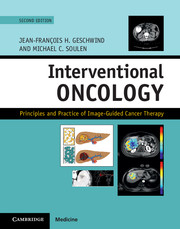Book contents
- Frontmatter
- Contents
- List of contributors
- Section I Principles of oncology
- Section II Principles of image-guided therapies
- 2 Principles of radiofrequency and microwave tumor ablation
- 3 Principles of irreversible electroporation
- 4 Principles of high-intensity focused ultrasound
- 5 Principles of tumor embolotherapy and chemoembolization
- 6 Principles of radioembolization
- 7 Principles of intra-arterial infusional chemotherapy in the treatment of liver metastases from colorectal cancer
- 8 Imaging in interventional oncology: Role of image guidance
- 9 Novel developments in MR assessment of treatment response after locoregional therapy
- Section III Organ-specific cancers – primary liver cancers
- Section IV Organ-specific cancers – liver metastases
- Section V Organ-specific cancers – extrahepatic biliary cancer
- Section VI Organ-specific cancers – renal cell carcinoma
- Section VII Organ-specific cancers – chest
- Section VIII Organ-specific cancers – musculoskeletal
- Section IX Organ-specific cancers – prostate
- Section X Specialized interventional techniques in cancer care
- Index
- References
5 - Principles of tumor embolotherapy and chemoembolization
from Section II - Principles of image-guided therapies
Published online by Cambridge University Press: 05 September 2016
- Frontmatter
- Contents
- List of contributors
- Section I Principles of oncology
- Section II Principles of image-guided therapies
- 2 Principles of radiofrequency and microwave tumor ablation
- 3 Principles of irreversible electroporation
- 4 Principles of high-intensity focused ultrasound
- 5 Principles of tumor embolotherapy and chemoembolization
- 6 Principles of radioembolization
- 7 Principles of intra-arterial infusional chemotherapy in the treatment of liver metastases from colorectal cancer
- 8 Imaging in interventional oncology: Role of image guidance
- 9 Novel developments in MR assessment of treatment response after locoregional therapy
- Section III Organ-specific cancers – primary liver cancers
- Section IV Organ-specific cancers – liver metastases
- Section V Organ-specific cancers – extrahepatic biliary cancer
- Section VI Organ-specific cancers – renal cell carcinoma
- Section VII Organ-specific cancers – chest
- Section VIII Organ-specific cancers – musculoskeletal
- Section IX Organ-specific cancers – prostate
- Section X Specialized interventional techniques in cancer care
- Index
- References
Summary
Tumor embolotherapy
General indications
The percutaneous angiographic technique was originally introduced by Seldinger, and modern embolotherapy was first attempted by Rösch et al. to control duodenal bleeding in 1972. The term embolization refers to the induction of vascular occlusion by introducing an embolic agent into a vessel through a selectively placed catheter for therapeutic purposes.
There are various indications of embolization, including bleeding control, tumor devascularization, arteriovenous fistulas and malformations, aneurysms, organ or tissue ablation, varicoceles, blood flow redistribution, and perigraft leakage. Tumors that are indicated for devascularization by embolotherapy include renal cell carcinoma, angiomyolipoma, hepatic tumors, bone and soft-tissue tumors, and uterine fibroids. Transcatheter arterial embolization (TAE) of liver tumors was first reported by Doyon et al., while chemoembolization using Gelfoam and anticancer drugs was originally reported by Yamada et al.
Recently, catheters with hydrophilic coatings and coaxial microcatheter systems have been developed, making possible the precise and safe delivery of embolic materials to any location in the body through blood vessels. The embolization process involves the precise localization of a target lesion, the selection of ideal embolic materials, the complete embolization of the target lesion, and the preservation of non-targeted regions. For effective embolization, the selective and superselective techniques are important in inducing complete embolization and preserving normal parenchyma and target organ function.
Embolic materials
Various embolic materials are now commercially available. Embolic materials must be chosen with the following characteristics in mind: embolization level (proximal or distal), regular size and shape (constant or changing), duration of occlusion (permanent or temporary), ease of injection through a catheter (solid, elastic, or liquid) and potential risk of complication. Many embolic materials have been introduced for TAE, such as gelatin sponge particles, microspheres, autologous blood clots, polyvinyl alcohol (PVA) particles, n-butyl cyanoacrylate (NBCA, glue), and absolute ethanol.
Gelfoam
Gelatin sponge (Gelfoam) is a porous, pliable product that is prepared from purified pork skin and applied to bleeding surfaces as a hemostatic. Gelfoam is the most frequently used embolic material for the devascularization of tumors, and for vascular occlusion for bleeding control. Gelatin sponge particles of 500–1,000 μm do not cause serious hepatic damage in experimental animals or humans with good hepatic functional reserve.
- Type
- Chapter
- Information
- Interventional OncologyPrinciples and Practice of Image-Guided Cancer Therapy, pp. 35 - 43Publisher: Cambridge University PressPrint publication year: 2016



